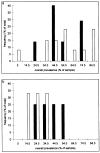Multispecies Plasmodium infections of humans
- PMID: 10207356
- PMCID: PMC2481388
Multispecies Plasmodium infections of humans
Abstract
We analyzed point-prevalence data from 19 recent studies of human populations in which either Plasmodium ovale or Plasmodium vivax co-occur with Plasmodium falciparum and Plasmodium malariae. Although the only statistical interactions among, sympatric congeners are pairwise, the frequencies of mixed-species infections relative to standard hypotheses of species sampling independence show no strong relation to overall malaria prevalence. The striking difference between the P. falciparum-P. malariae-P. ovale and the P. falciparum-P. malariae-P. vivax data is that the first typically shows a statistical surplus of mixed-species infections and the second a deficit. This suggests that the number of Plasmodium species present in a human population may be less important in determining the frequencies of mixed-species infections than is the identity of those species.
Figures




References
-
- Anthony RL, Bangs MJ, Hamzah N, Basri Purnomo H, Subianto B. Heightened transmission of stable malaria in an isolated population in the highlands of Irian Jaya, Indonesia. American Journal of Tropical Medicine and Hygiene. 1992;47:346–356. - PubMed
-
- Banchongaksorn T, Yomokgul P, Panyim S, Rooney W, Vickers P. A field trial of the ParaSight™-F test for the diagnosis of Plasmodium falciparum infection. Transactions of the Royal Society of Tropical Medicine and Hygiene. 1996;90:244–245. - PubMed
-
- Barnwell JW, Galinski MR. Plasmodium vivax: A glimpse into the unique and shared biology of the merozoite. Annals of Tropical Medicine and Parasitology. 1995;89:113–120. - PubMed
Publication types
MeSH terms
Grants and funding
LinkOut - more resources
Full Text Sources
Medical
